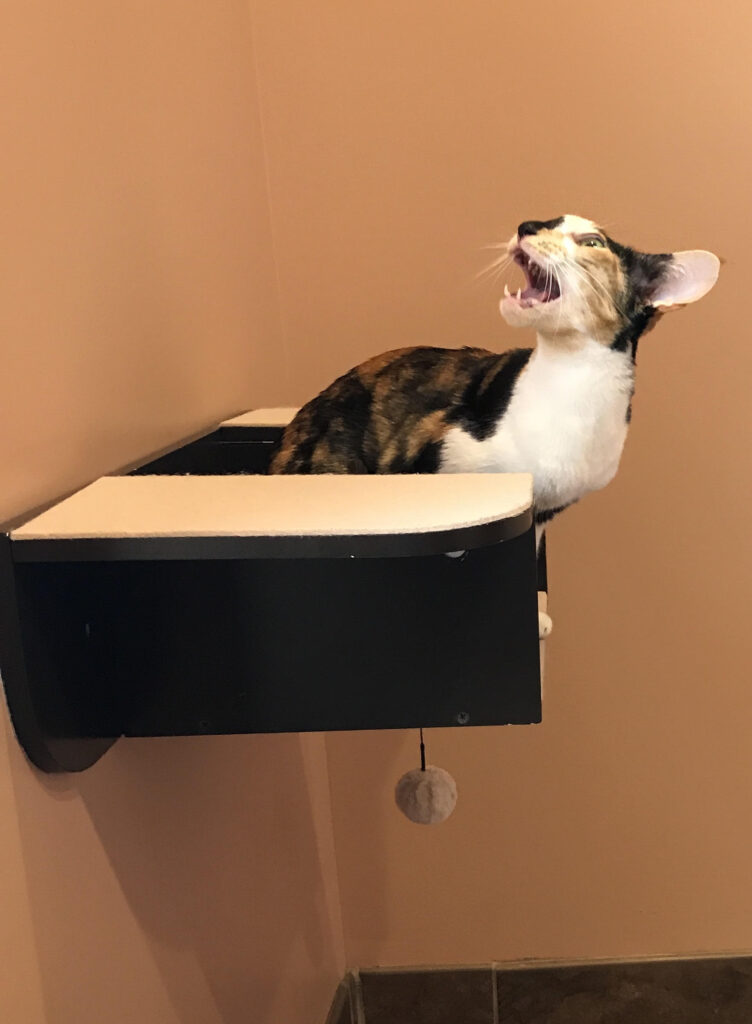
A happy cat means a happier household! There’s no need for the huge expense of replacing your carpets, rugs, or furniture. Nor any need for a strained relationship bnetween your felines and yourselves. I help cats (and their humans) internationally, and I can help you. Contact me by phone or email to schedule a time to discuss a solution to the problem.
Indications of the Problem
You’ll know it when you see it—or smell it. Your cat is either missing the litter box or choosing your rug, sofa, bed, floor or perhaps the bathtub. Maybe dribbles, maybe pools of urine. You might have seen your cat squatting or standing, her tail quivering, back feet treading—or not. Is your cat urinating in inappropriate places or is he marking territory? Is she/he urinating or defecating in the wrong places or both?
Possible Causes
There are several causes for your fur-friend to be doing this:
- There’s an infection or other medical problem that needs to be checked out with a trip to the vet. This is more common than you might expect.
- There may be a problem s/he’s having with the litter box itself. Cats are fastidious.
- Different kinds of stress—environmental, social, human, other cats, dogs, etc.—can often trigger an inappropriate peeing problem in cats. A cat can often display anxiety through her bladder.
- If the cat isn’t neutered (using this term for both female and male), hormone issues can often be the cause.
Potential Solutions
We need to establish if the cat is marking its territory or (just) peeing in the wrong places. Is there a medical cause? If not, then potential solutions could include:
Removing the appeal of the location s/he’s decided is a great place to pee, while improving the cleanliness of the correct place: his/her litter box. Laundry detergents won’t work for this—and despite what you might have read elsewhere, no vinegar, ammonia or bleach! These will actually attract and encourage your cat to “do its business” there! Instead, clean-thoroughly-–with an enzymatic cleaner designed especially for cat urine.
Decreasing the cat’s stress level by identifying and eliminating the cause of the stress. This requires the intervention of a trained cat behaviorist.
As a professionally-trained, specifically cat behaviorist with 40 years’ experience, I also manage other problems and fears; the aging cat, the feral cat and the stray cat can present special challenges of their own. These are the types of issues that require the skills of an experienced cat behaviorist.
*FOR THE FASTEST RESPONSE, PLEASE EMAIL ME DIRECTLY (JANE_EHR@HOTMAIL. COM), INSTEAD OF USING THE FORM. (It’s more reliable; I don’t always get form submissions!)* Also, as my Paypal account uses another email address, please use the form. Thank you!
Book a Urinating Consultation
***Regarding the COVID virus:
I do home visits if you are vaccinated (as I am), but happy to do phone consults, if you prefer. We can ‘video conference’ (via Skype, FaceTime, Messenger, etc.) where we’ll discuss the problem, observe your cat’s behavior live or on video, and then we can work out a plan.
Initial Telephone Chat: Complementary (Contact to Book) Let’s discuss the issues. I can ask you some questions, and we can schedule the appropriate consult.
Short Consultation (30+ mins): $95.00
After initial consultation (the more information I have, the better I can help), we can discuss certain problems that may not need a longer consultation.
In-Depth Consultation (60 mins): $195.00
This includes in-depth questioning during a one-hour-plus telephone call, and email follow-up report, with recommendations. Telephone/email follow-ups for 60 days included. Especially useful for national and international consults.
In-Home Consultation: $425.00
This includes extensive questioning by telephone, a one- to two-hour visit to your home for in-depth discussion and observation of your cat’s environment; email follow-up with further recommendations. Telephone/email follow-ups for next 60 days included.
